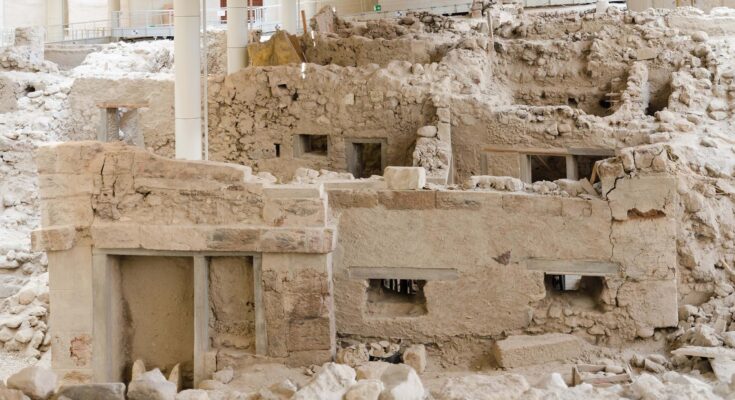On August 19, 1969, the Bronze Age city of Akrotiri on Santorini was uncovered, offering an extraordinary glimpse into a civilization preserved in volcanic ash. This discovery remains one of the most significant archaeological finds, revealing a sophisticated society that thrived over 3,600 years ago.
Akrotiri, the 3,600-year-old city on the island of Santorini buried by ash from a gigantic volcanic eruption in 1650 BC, frozen in its Bronze Age glory, serves as an exquisite time capsule for contemporary archaeologists who learn more every day about the mysterious lives of its inhabitants.
Located on the Greek island that was at that time called Thira after the mythical ruler of the island, Theras, the ancient city was part of the Minoan civilization, which flourished there and on the nearby island of Crete.
The eruption of the island—which had originally been called “Stronghili,” or “round”— decimated all life on the island and erased an entire city-state, which has been shown by archaeologists to have been part of the Minoan civilization.
The event was so cataclysmic that the ash cloud formed of what was left of the island of Thira circled the Earth for two years, according to ancient writers, plunging the Earth into a period of global cooling.
Elegant three and four-story buildings at Akrotiri, Santorini
With its elegant three and four-story buildings edged with colored stones, and resplendent public art, including frescoes, which bear witness to a highly-developed, and elegant culture, this begs the question of whether the island of Santorini was in fact Atlantis—the fabled city of great beauty that sank beneath the waves.
Was Santorini the same place that Plato wrote about which was punished for its hubris 1000 years before the Acropolis was built?
The question may never be answered to everyone’s satisfaction, but the evidence is mounting that this may be true.

Plato, in his writings “Timaeus” and “Critias,” described the beauties of the once great and militarily powerful island, whose inhabitants became so enamored with themselves and so arrogant that the gods destroyed the city as punishment.
The brilliant Ancient Greek philosopher stated that the city once even besieged Athens itself with its naval forces, but the Athenians effectively repelled the attack; the island nation was subsequently punished by the gods for its hubris, sinking underneath the waves of the Aegean.
A recent documentary airing on the Discovery Channel as part of its series Blowing Up History says that the ancient lost city of Atlantis may indeed have been the Greek island of Santorini.
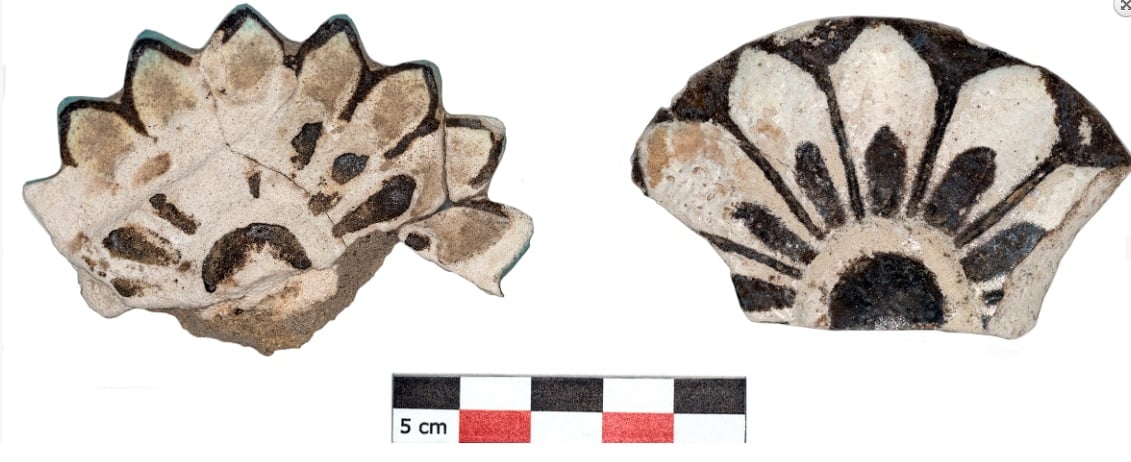
Covered by 200 feet of ash from the volcanic explosion, unfathomable artistic riches of extravagant wealth have been unearthed recently in Akrotiri on the southern tip of the island. These have offered up yet more tantalizing clues as to Santorini’s real identity.
The city was so completely buried in volcanic ash that the remains of fine frescoes and many other artworks and objects have been well-preserved, much like what occurred later in the city of Pompeii near Italy’s Mt. Vesuvius.
The event arresting life as it was at that moment enables us to look at the city today just as it had last been viewed by its inhabitants.
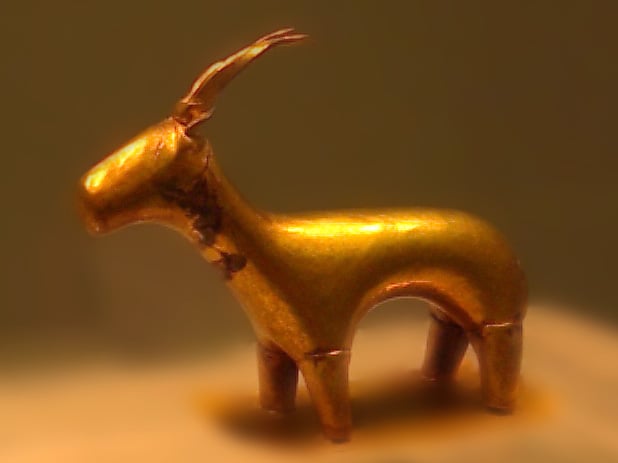
Much of the prehistoric city of Akrotiri had been destroyed by an earthquake that immediately preceded the volcanic eruption.
Christos Doumas, Emeritus Professor of Prehistoric Archaeology at Athens University, who has served as the director of the excavations at Akrotiri since 1975, believes that a few days passed between the earthquake and the volcanic explosion.
He says that the archaeological finds show that numerous people returned after the quake in order to start working on home reparations. Unfortunately, the temblor was just a prelude to the enormous eruption of the volcano only days afterwards.
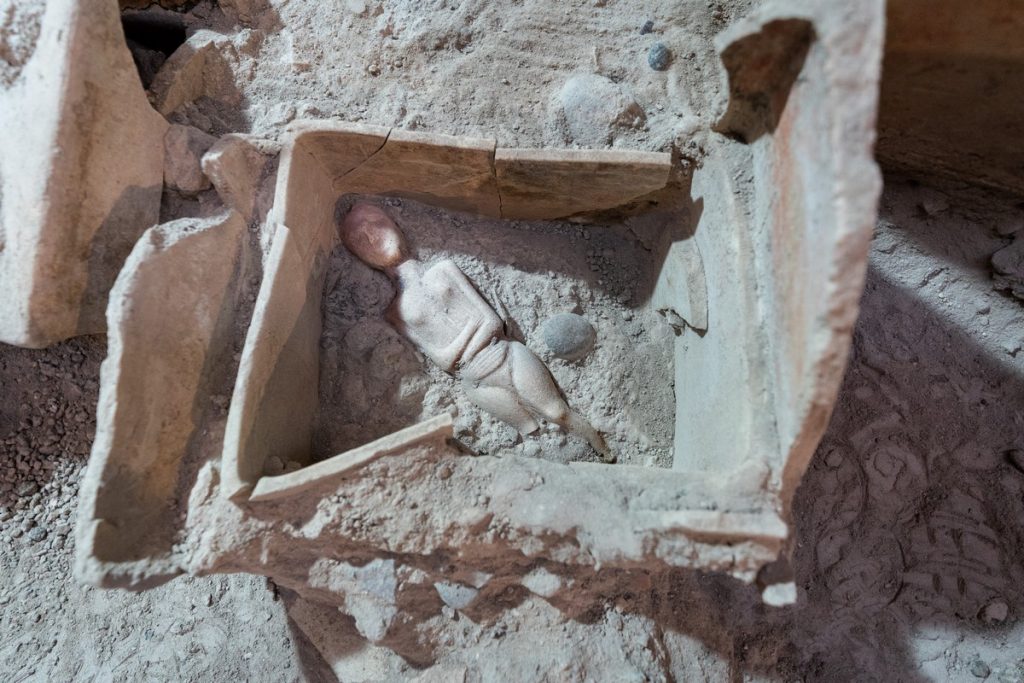
During the eruption, there were strong winds from the west, scientists say; thus all the ash and fumes were transported toward the east of the island. The inhabitants most likely never had time to evacuate the whole island—and even if they had, it is doubtful that they would have survived to make it to another island over the sea in these conditions.
Significant new findings were recently revealed during ongoing excavation works at the archaeological site of Akrotiri, the Ministry of Culture of Greece announced in a statement after its 2020 excavations.
Most of the recent discoveries are related to the everyday lives of the people who lived on the island before the volcanic explosion which destroyed most of the island and may have also dealt a death blow to the Minoan civilization on Crete.

The ordinary objects used by the people of the island—even, incredibly, clothing and burned fruit—that were found in the 2020 excavations, were most likely the very last objects the people of Santorini were using in the moments before the devastating volcanic eruption.
Additionally, more than 130 vessels were found, which archaeologists believe were most likely related to a burial place.
The statement from the Ministry of Culture issued after the 2020 dig said that among the new discoveries were four vessels that were partially unearthed in earlier excavations.
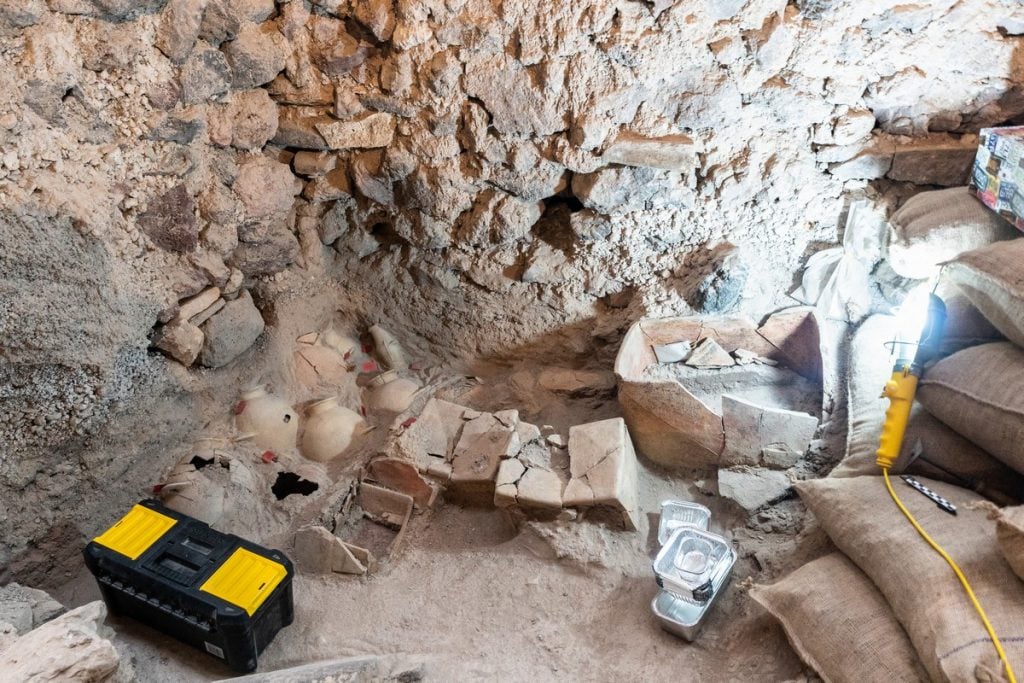
Other findings include bronze objects, including two large double braids and miniature horn cores, as well as small fragments and beads from one or more necklaces.
Among dozens of other new findings, the Ministry of Culture noted that an inscription, consisting of Linear A syllables and an ideogram, was found written in ink on an object which is most likely related to the use of a building, also uncovered in the dig.
The Ministry of Culture concluded by saying that scientists expect many additional smaller and larger findings to be uncovered in the next phases of excavations, which continue at the Akrotiri site.

The island’s culture flourished 3,000 years ago before its inhabitants were so violently killed by the volcanic eruption—but researchers say its civilization had been in existence for thousands of years prior to that time.
Since its discovery in the mid-19th century, more and more paintings, objects, and buildings have been uncovered, each one pointing to an extremely advanced and wealthy civilization.
The new documentary states: “Clues to this connection can be found in the incredible frescoes that decorate the walls of every home.”
The frescoes found at Akrotiri are especially important in the study of Minoan art because they are so much better preserved than those at Knossos and other sites on Crete, which have nearly all survived only in small fragments, usually scattered on the ground.
Civilization at Thira Flourished for Thousands of Years Before Eruption
The Discovery Channel’s new film lends new credence to the theory that the island of Santorini may indeed be the location of the fabled city.
Protected now by state-of-the-art roofing, researchers continue to unearth more treasures from the past which were buried at Akrotiri, much like at Pompeii, preserving a civilization and traces of a people that have been lost forever.
Just as Plato described, “These vibrant paintings depict a paradise full of swirling [colors], flowers and exotic animals. They capture a snapshot of the locals. They are evidence of a highly sophisticated and wealthy civilization,” Discovery Channel historians say.
Although no other writers of that time—or admittedly at any other time—described Atlantis, Plato’s words have lived on in history, and thousands of historians have attempted to pinpoint the exact location of the wealthy island that was seen as a paradise on earth.
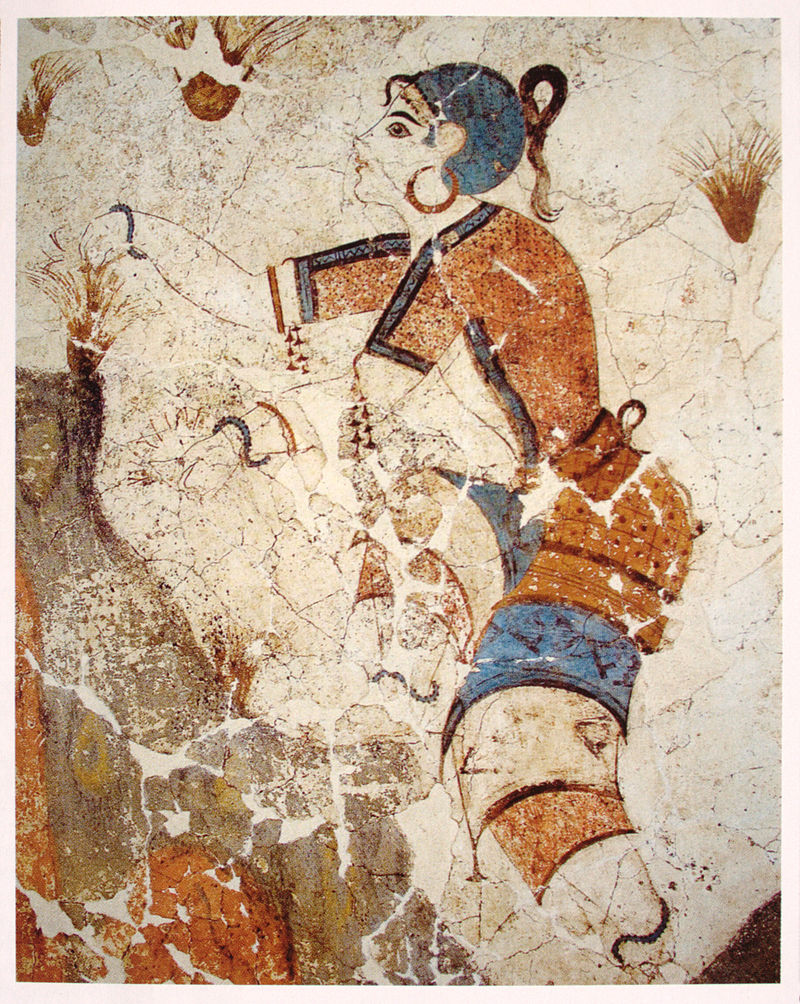
However, the fact that Atlantis disappeared nearly instantly after the cataclysmic eruption of the ancient volcano “leads many to believe Santorini is the lost island of Atlantis,” according to the documentary.
“In its prime,” it is stated in the film, “its narrow streets are intricately paved with stone and its town square is lined with picturesque houses which tower three and four stories high. An array of colorful stones decorate the facades.”
“The ruins suggest a highly sophisticated civilization flourished here for thousands of years before its abrupt end,” it is said.

The film shows how the island was struck by a volcanic eruption, as described by Plato.
The gigantic eruption, which is considered to be one of the largest in the last several thousand years, created twenty-mile-high clouds that rained ash on lands as far away as Egypt–200 miles from Santorini.
“Ancient writers described how the ash cloud plunges the world into darkness, causing a global winter for two years,” the narrator says.
The blast was so enormous that it used up almost the entire mountain’s land mass, creating a huge caldera inside the “arms” of Santorini, as the remains form a giant crescent shape.

The shape of the island was instantly changed forever after the fateful blast, with the entire seven-mile diameter of the caldera an active volcano even now although it has been filled in by seawater.
More than 3,000 years afterwards, the fascination about the possibility that the original island may actually be the lost Atlantis continues to intrigue archaeologists and historians today.
Akrotiri was uncovered by Greek archaeologist Spyros Marinatos in 1967. Ever since, it has been one of the world’s largest ongoing excavation projects. Whether or not Santorini is the lost island of Atlantis, its treasures show the staggering beauty and great elegance of a now-lost civilization.
Admittedly, Plato is known to have borrowed some of his stories, allegories, and metaphors from older oral traditions, and it may never be demonstrated beyond a shadow of a doubt that Santorini is the same storied island that sank beneath the waves.
Still, it seems that there is a great deal of circumstantial evidence that this fantastically wealthy island—with its paved streets, beautifully-decorated homes and luxuries of every kind—just may be the same Atlantis that has gone down in history and folklore.
The Continuing Excavations at Akrotiri
Akrotiri’s excavation continues to unearth new findings that deepen our understanding of this ancient civilization. Recent discoveries include intricate frescoes, well-preserved artifacts, and even remnants of daily life, such as pottery and tools. These finds provide further evidence of the advanced society that once inhabited the island, suggesting a level of sophistication comparable to that of other major Bronze Age cultures.
- New Artifacts: Ongoing excavations have revealed more everyday objects, offering insights into the daily lives of Akrotiri’s inhabitants, including their diet, clothing, and social structure.
- Technological Advances in Preservation: Modern techniques in archaeological preservation are being employed to protect and analyze the fragile remains, ensuring that these invaluable pieces of history are maintained for future generations.
- Impact on Understanding Minoan Culture: The discoveries at Akrotiri have had a significant impact on the study of Minoan culture, providing a clearer picture of its influence across the Aegean and its connections with other ancient civilizations.
